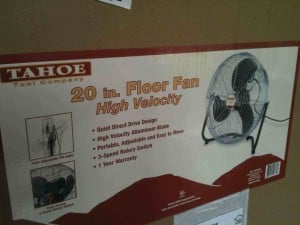Dear Fellow Basement Scientists,
I hope you all are pursuing your interests and attempting to satisfy your curiosity. With many other good things, it is fun and rewarding, but can take hard work. Alright, in our wind tunnel project our next piece of construction takes us to the diffuser! Recall our general wind tunnel design (in blue), appropriately drawn on the back on an envelope, You can see the diffuser on the right of the test section, it is long and expands to larger than the fan, in order to house it:
What is a diffuser you say. Well, the diffuser is the opposite of the bell mouth. It takes the air from the small test section of the wind tunnel and expands to the large area of the fan. Therefore, if construction is broken into 4 parts: the lift/drag gauge, test section, bell mouth, and diffuser/fan we are onto the final quarter of this project! … however, it is important to remember that I just grouped diffuser and fan into one category, and building the diffuser and building the fan housing are no small tasks. Realizing all this work provides for a little aside. ->
I am now in my second year of grad school and through my own experiences and talking with older students I have learned something very interesting about performing research, even at the university level. This is that the majority of your time can be spent planning and creating the experiment, and a very small fraction actually performing it! This is because experiments must be planned, parts must be design, equipment must be ordered, and bugs must be worked out. Building a complex experiment is somewhat like building car from scratch. However, often no one else wants it, so you build it once, use it and toss it aside and move onto the next thing! This is often the nature of research since you are usually doing something no one else has ever done. Which makes it hard, time consuming, and rewarding. This reminds me of an Albert Einstien quote:
“If we knew what we were doing, it wouldn’t be called research, would it?”
Since I have rambled a little bit, I will not go into diffuser design, but finish this post with our purchase of a fan. That’s right, the fan is purchased. Actually, I bought two fans. Don’t worry, one was used from Craigslist and was really cheap, which explains why I then had to go buy another one. And here it is:
And here is the explanation: The surface we are working on is a little more than 2ft, so we need a fan smaller than this to make room for the diffuser to go around it. Three more constraints on this part are that we want it to have variable speed – to vary the speed in the wind tunnel – we want it to be as powerful as possible, measured in cubic feet per minute (CFM) – to get the highest speeds possible-, be as inexpensive as possible – because we have to buy it-, and lastly it must be able to be removed from its original housing – so we can put it into the diffuser. I looked through a lot of fans at stores and websites, but found the one which best fulfilled all these needs: it is the Tahoe 1/4 horsepower floor fan: see here. It says it can move 5600 CFM, which is a lot. However, wikipedia says that CFM is just a general term and these numbers should not be taken precisely, oh well. So I bought it, but, as directed, will not be hard nosed about its actual CFM capacity … .
If we actually get 5600 CFM we can move air at 120mph through the wind tunnel. That would be very exciting! Until next time, keep exploring!
Best Regards,
Ben Washington

